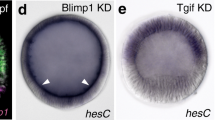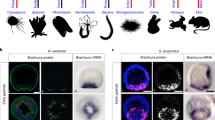Abstract
Specification of endoderm is the prerequisite for gut formation in the embryogenesis of bilaterian organisms. Modern lineage labelling studies1,2,3 have shown that in the sea urchin embryo model system, descendants of the veg1 and veg2 cell lineages produce the endoderm, and that the veg2 lineage also gives rise to mesodermal cell types. It is known that Wnt/β-catenin signalling is required for endoderm specification4,5,6 and Delta/Notch signalling is required for mesoderm specification7,8,9. Some direct cis-regulatory targets of these signals have been found10,11 and various phenomenological patterns of gene expression have been observed in the pre-gastrular endomesoderm. However, no comprehensive, causal explanation of endoderm specification has been conceived for sea urchins, nor for any other deuterostome. Here we propose a model, on the basis of the underlying genomic control system, that provides such an explanation, built at several levels of biological organization. The hardwired core of the control system consists of the cis-regulatory apparatus of endodermal regulatory genes, which determine the relationship between the inputs to which these genes are exposed and their outputs. The architecture of the network circuitry controlling the dynamic process of endoderm specification then explains, at the system level, a sequence of developmental logic operations, which generate the biological process. The control system initiates non-interacting endodermal and mesodermal gene regulatory networks in veg2-derived cells and extinguishes the endodermal gene regulatory network in mesodermal precursors. It also generates a cross-regulatory network that specifies future anterior endoderm in veg2 descendants and institutes a distinct network specifying posterior endoderm in veg1-derived cells. The network model provides an explanatory framework that relates endoderm specification to the genomic regulatory code.
This is a preview of subscription content, access via your institution
Access options
Subscribe to this journal
Receive 51 print issues and online access
$199.00 per year
only $3.90 per issue
Buy this article
- Purchase on Springer Link
- Instant access to full article PDF
Prices may be subject to local taxes which are calculated during checkout




Similar content being viewed by others
References
Cameron, R. A., Fraser, S. E., Britten, R. J. & Davidson, E. H. Macromere cell fates during sea urchin development. Development 113, 1085–1091 (1991)
Logan, C. Y. & McClay, D. R. The allocation of early blastomeres to the ectoderm and endoderm is variable in the sea urchin embryo. Development 124, 2213–2223 (1997)
Ransick, A. & Davidson, E. H. Late specification of Veg1 lineages to endodermal fate in the sea urchin embryo. Dev. Biol. 195, 38–48 (1998)
Byrum, C. A., Xu, R., Bince, J. M., McClay, D. R. & Wikramanayake, A. H. Blocking Dishevelled signaling in the noncanonical Wnt pathway in sea urchins disrupts endoderm formation and spiculogenesis, but not secondary mesoderm formation. Dev. Dyn. 238, 1649–1665 (2009)
Logan, C. Y., Miller, J. R., Ferkowicz, M. J. & McClay, D. R. Nuclear β-catenin is required to specify vegetal cell fates in the sea urchin embryo. Development 126, 345–357 (1999)
Wikramanayake, A. H. et al. Nuclear β-catenin-dependent Wnt8 signaling in vegetal cells of the early sea urchin embryo regulates gastrulation and differentiation of endoderm and mesodermal cell lineages. Genesis 39, 194–205 (2004)
Sherwood, D. R. & McClay, D. R. LvNotch signaling mediates secondary mesenchyme specification in the sea urchin embryo. Development 126, 1703–1713 (1999)
Sweet, H. C., Hodor, P. G. & Ettensohn, C. A. The role of micromere signaling in Notch activation and mesoderm specification during sea urchin embryogenesis. Development 126, 5255–5265 (1999)
Sweet, H. C., Gehring, M. & Ettensohn, C. A. LvDelta is a mesoderm-inducing signal in the sea urchin embryo and can endow blastomeres with organizer-like properties. Development 129, 1945–1955 (2002)
Ransick, A. & Davidson, E. H. cis-regulatory processing of Notch signaling input to the sea urchin glial cells missing gene during mesoderm specification. Dev. Biol. 297, 587–602 (2006)
de-Leon, S. B. & Davidson, E. H. Information processing at the foxa node of the sea urchin endomesoderm specification network. Proc. Natl Acad. Sci. USA 107, 10103–10108 (2010)
Howard-Ashby, M. et al. Identification and characterization of homeobox transcription factor genes in Strongylocentrotus purpuratus, and their expression in embryonic development. Dev. Biol. 300, 74–89 (2006)
Howard-Ashby, M. et al. Gene families encoding transcription factors expressed in early development of Strongylocentrotus purpuratus . Dev. Biol. 300, 90–107 (2006)
Materna, S. C., Howard-Ashby, M., Gray, R. F. & Davidson, E. H. The C2H2 zinc finger genes of Strongylocentrotus purpuratus and their expression in embryonic development. Dev. Biol. 300, 108–120 (2006)
Rizzo, F., Fernandez-Serra, M., Squarzoni, P., Archimandritis, A. & Arnone, M. I. Identification and developmental expression of the ets gene family in the sea urchin (Strongylocentrotus purpuratus). Dev. Biol. 300, 35–48 (2006)
Tu, Q., Brown, C. T., Davidson, E. H. & Oliveri, P. Sea urchin Forkhead gene family: phylogeny and embryonic expression. Dev. Biol. 300, 49–62 (2006)
Peter, I. S. & Davidson, E. H. The endoderm gene regulatory network in sea urchin embryos up to mid-blastula stage. Dev. Biol. 340, 188–199 (2010)
Minokawa, T., Wikramanayake, A. H. & Davidson, E. H. cis-Regulatory inputs of the wnt8 gene in the sea urchin endomesoderm network. Dev. Biol. 288, 545–558 (2005)
Smith, J., Kraemer, E., Liu, H., Theodoris, C. & Davidson, E. A spatially dynamic cohort of regulatory genes in the endomesodermal gene network of the sea urchin embryo. Dev. Biol. 313, 863–875 (2008)
Peter, I. S. & Davidson, E. H. Modularity and design principles in the sea urchin embryo gene regulatory network. FEBS Lett. 583, 3948–3958 (2009)
Croce, J. C. & McClay, D. R. Dynamics of Delta/Notch signaling on endomesoderm segregation in the sea urchin embryo. Development 137, 83–91 (2010)
Davidson, E. H. Emerging properties of animal gene regulatory networks. Nature 468, 911–920 (2010)
Smith, J., Theodoris, C. & Davidson, E. H. A gene regulatory network subcircuit drives a dynamic pattern of gene expression. Science 318, 794–797 (2007)
Livi, C. B. & Davidson, E. H. Regulation of spblimp1/krox1a, an alternatively transcribed isoform expressed in midgut and hindgut of the sea urchin gastrula. Gene Expr. Patterns 7, 1–7 (2007)
Ransick, A. Detection of mRNA by in situ hybridization and RT-PCR. Methods Cell Biol. 74, 601–620 (2004)
Oliveri, P., Tu, Q. & Davidson, E. H. Global regulatory logic for specification of an embryonic cell lineage. Proc. Natl Acad. Sci. USA 105, 5955–5962 (2008)
Longabaugh, W. J., Davidson, E. H. & Bolouri, H. Visualization, documentation, analysis, and communication of large-scale gene regulatory networks. Biochim. Biophys. Acta 1789, 363–374 (2009)
Rast, J. P. et al. Recovery of developmentally defined gene sets from high-density cDNA macroarrays. Dev. Biol. 228, 270–286 (2000)
Materna, S. C. & Oliveri, P. A protocol for unraveling gene regulatory networks. Nature Protocols 3, 1876–1887 (2008)
Revilla-i-Domingo, R., Oliveri, P. & Davidson, E. H. A missing link in the sea urchin embryo gene regulatory network: hesC and the double-negative specification of micromeres. Proc. Natl Acad. Sci. USA 104, 12383–12388 (2007)
Acknowledgements
We acknowledge technical assistance from J. Yun, who executed much of the perturbation analysis matrix, and from A. Puszynska and E. Erkenbrack, who contributed to whole-mount in situ hybridization results. We are grateful to E. Rothenberg for a detailed critique of the manuscript. I.S.P. was the recipient of a fellowship from the Swiss National Science Foundation in the initial stages of this work. The research was supported by National Institutes of Health grant HD37105 to E.H.D.
Author information
Authors and Affiliations
Contributions
This research was conceived by I.S.P. and E.H.D. and all experiments were designed and executed by I.S.P. with the assistance acknowledged above. The results were interpreted by I.S.P. and E.H.D., who also contributed jointly to the manuscript.
Corresponding authors
Ethics declarations
Competing interests
The authors declare no competing financial interests.
Supplementary information
Supplementary Information
The file contains Supplementary Tables 1-6, Supplementary Figures 1-8 with legends and additional references. (PDF 23364 kb)
Rights and permissions
About this article
Cite this article
Peter, I., Davidson, E. A gene regulatory network controlling the embryonic specification of endoderm. Nature 474, 635–639 (2011). https://doi.org/10.1038/nature10100
Received:
Accepted:
Published:
Issue Date:
DOI: https://doi.org/10.1038/nature10100
This article is cited by
-
Feedback circuits are numerous in embryonic gene regulatory networks and offer a stabilizing influence on evolution of those networks
EvoDevo (2023)
-
The evolutionary history of Brachyury genes in Hydrozoa involves duplications, divergence, and neofunctionalization
Scientific Reports (2023)
-
Identification and interrogation of the gene regulatory network of CEBPA-double mutant acute myeloid leukemia
Leukemia (2023)
-
Gene expression and transcriptional regulation driven by transcription factors involved in congenital heart defects
Irish Journal of Medical Science (1971 -) (2023)
-
A mosaic of conserved and novel modes of gene expression and morphogenesis in mesoderm and muscle formation of a larval bivalve
Organisms Diversity & Evolution (2022)
Comments
By submitting a comment you agree to abide by our Terms and Community Guidelines. If you find something abusive or that does not comply with our terms or guidelines please flag it as inappropriate.



